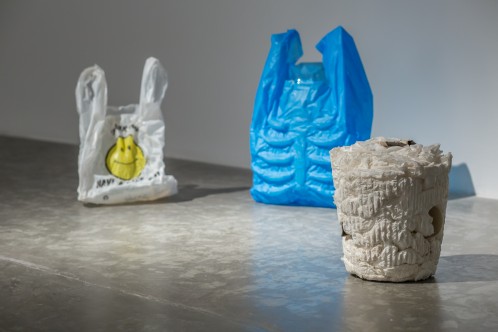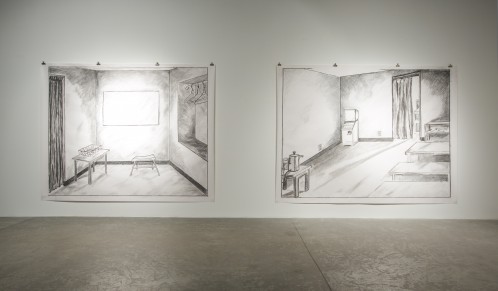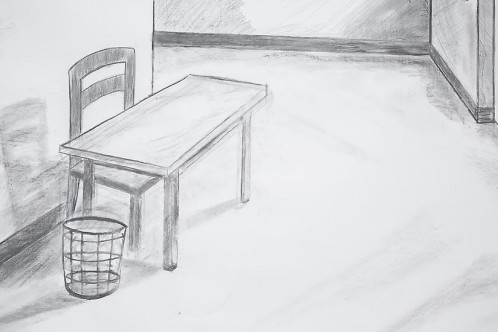In conversation with Shadi Habib Allah
Dubai
In 2009, Shadi Habib Allah was traveling to New York with a sculpture cast of a leg he had made in Palestine. Upon arrival at Ben Gurion airport in Tel Aviv, Habib Allah was interrogated about the use and meaning of the sculptural work. After being passed up the chain of security and responding to a myriad of questions, the artist was separated from the work and the sculpture was stripped of its recognition as an artwork, eventually being destroyed without the artist’s knowledge. An institutional aesthetic judgement that had unforeseen consequences.
Shadi Habib Allah regained his strength and developed a new body of work that he just showed at Dubai-based Green Art Gallery.
We sat down with Shadi Habib Allah and discussed this decisive event.
Wertical: When and how did you realize your passion for art and endeavor to become a professional artist?
Shadi Habib Allah: There was a bird that would come and stand on the electric wire in the neighborhood every Friday. I would notice him if I was sitting next to the window. He always had a twig in his beak. He would fly with it to the top of a building several miles away where he would build his nest. The sight of that nest made me want to replicate it, weaving twigs and sticks together to make the nest. But of course it was a failed attempt. And the realization of that failure made me proceed with nest like shape into something that forgot its intended purpose. With progression, the practice stops being about executing each project separately to fit into a stream of unity, rather it becomes about the discontinuity or the disharmony of the practice as a whole. Viewing it in that manner helps me maintain a distance from the subject and the materials of the work. And the idea for the beginning of a work is just a vehicle that gets discarded down the way.
WE: If you had to describe your artworks to somebody who didn’t have a chance to see them yet, what would you say?
SHA: When you look at something from a close range and you examine it, it is already catching your attention. You would probably research it then, it gives you a kind of understanding and in depth information that accumulates as a data. That info, you can shuffle around in various arrangements and overtime you’ll have that compositional mastery just like composition homework in elementary and high school. You can now take bigger and larger topics for your projects and apply that compositional strategy. On the other hand, If you examine something from a distance, you dictate your parameter of accessibility and the kind of understanding you can have towards the subject. My work relates to the second approach mentioned here and is still an ongoing inquiry.
WE: Your new series of works stems form an incident in 2009 when airport security didn’t look upon your work as a piece of art and destroyed it. Does your art help you coming to terms with the situation?
SHA: An obstacle hinders an intended progression of something and it demands a reorganization of a posture, in order to proceed. It opens up a dialogue even if you don’t reach a specific goal. I feel that in my work I try to situate myself within a condition. What stance do I take and what is the rhythm?
WE: Does your work refer to personal experiences in general?
SHA: It is important to think about how you define personal these days. Is it the time in which you physically encounter everything around you, such as walking in the street? Or any space that you are in? Does cyber-time qualify as personal encounter? Or does there have to be an incident that consumes your attention to qualify it as personal? If all are true, then I could call my work starting from a personal experience. Or maybe there is no such thing as ‘personal’.
WE: Your just bygone exhibition was entitled Evacuated Containers; what does it allude to?
SHA: It’s a title that doesn’t necessary have to refer to the work. But maybe it could refer to the draining out of the subject of the work and its intended context. The vacated set intentionally negates the representation of bodies leaving only the reconstructed memory of the space. These empty spaces allow for a multiplicity of potentials to unfold and inhabit the work.



March 18 – May 5, 2013
Al Quoz 1, Street 8, AlSerkal Avenue, Unit 28
P.O. Box 257 11 Dubai
UAE
Archive
- Dezember 2016 (1)
- Oktober 2016 (3)
- September 2016 (24)
- Juli 2016 (20)
- Juni 2016 (24)
- Mai 2016 (18)
- April 2016 (18)
- März 2016 (21)
- Februar 2016 (11)
- Januar 2016 (20)
- Dezember 2015 (20)
- November 2015 (37)
- Oktober 2015 (30)
- September 2015 (24)
- August 2015 (4)
- Juli 2015 (30)
- Juni 2015 (9)
- Mai 2015 (17)
- April 2015 (23)
- März 2015 (18)
- Januar 2015 (8)
- Dezember 2014 (1)
- November 2014 (3)
- Oktober 2014 (10)
- September 2014 (4)
- August 2014 (2)
- Juli 2014 (3)
- Juni 2014 (2)
- Mai 2014 (5)
- April 2014 (11)
- März 2014 (12)
- Februar 2014 (13)
- Januar 2014 (10)
- Dezember 2013 (5)
- November 2013 (13)
- Oktober 2013 (24)
- September 2013 (18)
- August 2013 (26)
- Juli 2013 (13)
- Juni 2013 (35)
- Mai 2013 (44)
- April 2013 (49)
- März 2013 (61)
- Februar 2013 (54)
- Januar 2013 (46)
- Dezember 2012 (50)
- November 2012 (58)
- Oktober 2012 (62)
- September 2012 (61)
- August 2012 (63)
- Juli 2012 (64)
- Juni 2012 (61)
- Mai 2012 (63)
- April 2012 (51)
- März 2012 (67)
- Februar 2012 (37)



